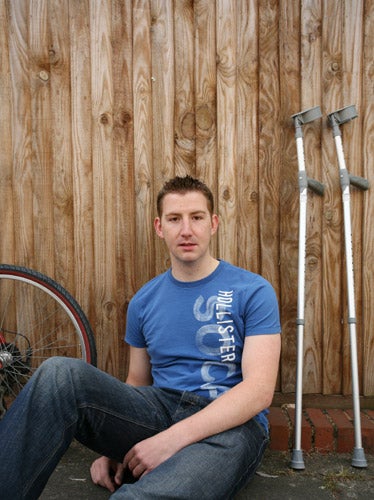First person: 'I wiped out on Bolivia's Road of Death'
Ryan Chamberlain, 23

It was the worst birthday I've ever had. It was 3 April last year and I had taken a gap year after university to travel with friends around South America. I was planning to start officer training at Sandhurst in January, but all that changed in an instant when we decided to cycle Bolivia's "Road of Death".
The road, in the country's Yungas region, north-east of capital La Paz, is a 69km run down a mountain cliff. Its name isn't just for effect. Some 200 people die on it every year, mostly plunging off its sheer edge. It is popular with tourists: close to 25,000 a year either walk or cycle down it. It starts in the mountains and zigzags to the country's lush, green rainforest below. And it's pretty hairy.
My friends and I decided it would be a great way to mark my birthday. About 15 of us joined a specialist tour group, with guides. I was at the front and we were coasting down the hill when a guy in a car came around the corner too fast, on the wrong side of the road, and ploughed into us. We found out later he was drunk.
Because I was at the front I got hit the worst. He drove straight over me. My foot was hanging off the bone. I broke my pelvis, two ribs and shattered my left eye socket. Luckily one of the guides with us was an off-duty paramedic, so he made sure I was moved properly and got me to the hospital.
The doctors there were amazing. My foot didn't look like it could be saved, but they were determined to have a go. They re-attached it and put on a metal frame screwed into the bones to hold it together. I was in hospital there for three weeks. They fixed my pelvis by putting in a plate and four screws, as well as my eye, which they built up with mesh and another four plates.
My insurance company told me I was going to have a private plane to take me from La Paz to Sao Paulo, so that I could fly back to the UK. I was excited about that to begin with. It ended up being an eight-seater plane with four seats ripped out. I was dumped on the floor. The route should have taken three hours, but in our tin-can private plane it took us 12. We needed three pit stops to refuel.
Back home, I was taken straight to Accident and Emergency at St George's in London. They found a deep infection. I was in hospital for another four weeks, and during 13 operations they had to remove more tendons and ligaments than had been lost already.
It was four months after the accident before I could start physiotherapy and hydrotherapy. But when I tried standing, my ankle crumpled because of the lack of ligaments. The doctors tried me with orthotics – special devices in the shoe that support the foot – but they couldn't compensate for the internal damage.
Finally the surgeon said the only way to keep my foot was to fuse the bones, which would lock the ankle. I would be able to walk without crutches, and with less pain than I'd had for the last year, but the mountain sports that were my life would have been out of the question. That was when I knew I had to make a difficult choice.
I asked about a below-knee amputation, and having a prosthetic fitted. My surgeon agreed, but I had to see two other doctors and they had to concur. In fact, they not only agreed it was my best course, but said eventually I would have probably lost the foot anyway because of the nerve damage.
Now I am waiting for the amputation. My goal is to run the London Marathon for Save the Children next year. It's something to aim for which is more substantial than just getting my fitness back, and a way to turn the accident into something more positive, but it's daunting. Until now I've never run more than 10 miles – with both my legs.
Join our commenting forum
Join thought-provoking conversations, follow other Independent readers and see their replies
Comments